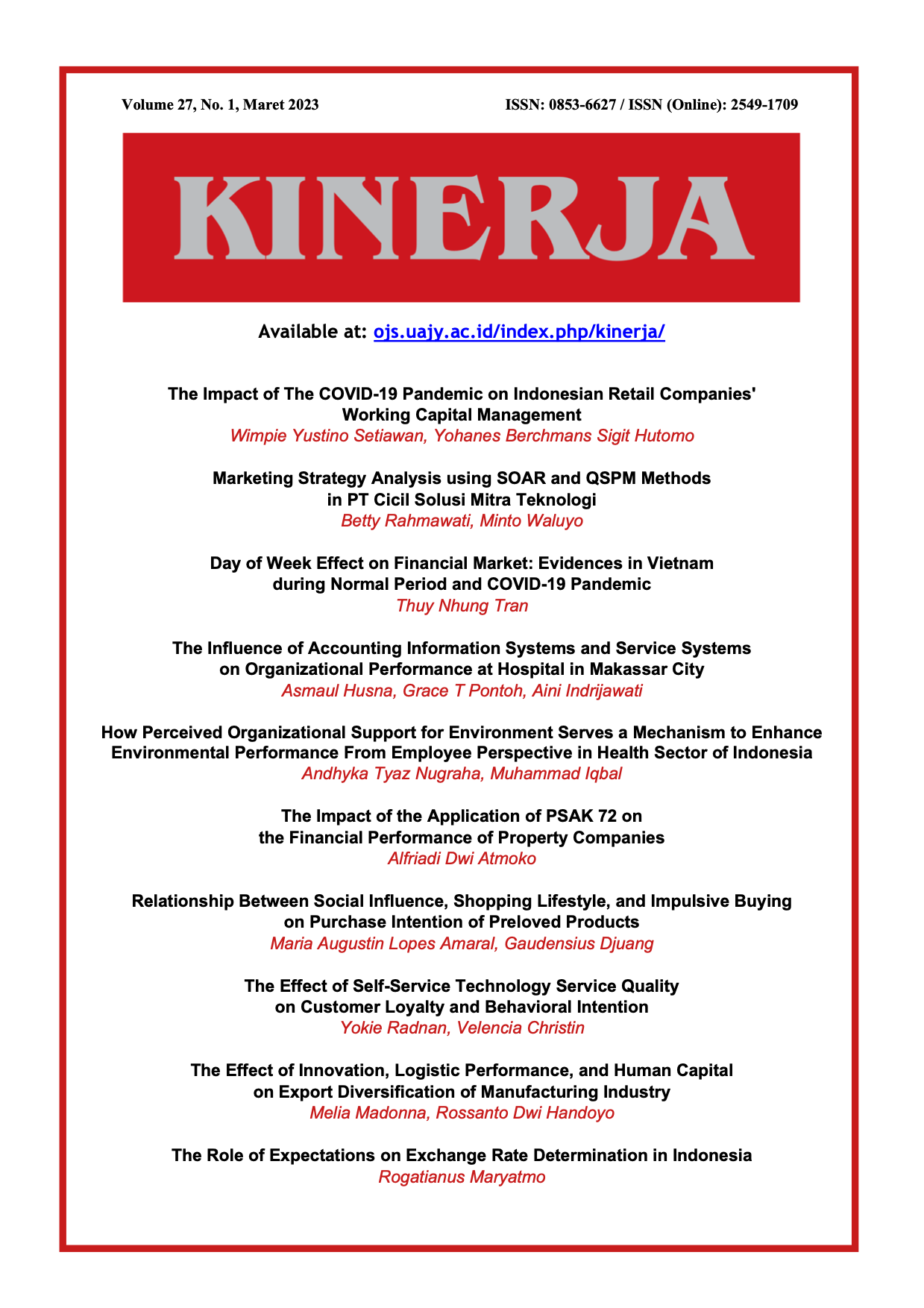The Effect of Innovation, Logistic Performance, and Human Capital on Export Diversification of Manufacturing Industry
DOI:
https://doi.org/10.24002/kinerja.v27i1.6459Keywords:
export diversification, innovation, logistics performance, human capitalAbstract
This study aimed to analyze the effect of innovation, logistics performance, and human capital on export diversification of the manufacturing industry based on technology intensity in Indonesia. This study uses the method of moments approach with estimation using the Generalized Method of Moments (GMM). The research was conducted using dynamic data panels belonging to Indonesia and 30 main export destination countries as research objects. The results show the average Global Innovation Index (GII) of Indonesia and export countries, the average Logistics Performance Index (LPI) of Indonesia and export destination countries, the labor force with intermediate education, labor force with basic education. Indonesia's GDP has a positive and significant effect on the diversification of manufacturing industry commodity exports in Indonesia across all technological intensities. Still, the importers' GDP and exchange rates positively influence the spread of diversification exports of manufactured industrial commodities in Indonesia, but some models show no significant relationship.
References
Agosin, M. R., Alvarez, R., & Bravo‐Ortega, C., 2012. Determinants of export diversification around the world: 1962–2000. The World Economy, 35(3), 295-315.
Andersson, M., & Johansson, S., 2010. Human capital and the structure of regional export flows. Technology in Society, 32(3), 230-240.
Aneja, R., & Arjun, G., 2021. Estimating components of productivity growth of Indian high and medium-high technology industries: A non-parametric approach. Social Sciences & Humanities Open, 4(1), 100180.
Auray, S., Fuller, D. L., & Vandenbroucke, G., 2021. Comparative advantage and moonlighting. European Economic Review, 139, 103897.
Azar, G., & Ciabuschi, F., 2017. Organizational innovation, technological innovation, and export performance: The effects of innovation radicalness and extensiveness. International business review, 26(2), 324-336.
Baltagi, B. H., 2008. Econometric Analysis of Panel Data (Vol. 4). Chichester: John Wiley & Sons.
Bayraktutan, Y., & Bıdırdı, H., 2018. Innovation and high-tech exports in developed and developing countries. Journal of International Commerce, Economics and Policy, 9(03), 1850011.
Bierut, B. K., & Kuziemska-Pawlak, K., 2017. Competitiveness and export performance of CEE countries. Eastern European Economics, 55(6), 522-542.
Blanchard, E. J., & Olney, W. W., 2017. Globalization and human capital investment: Export composition drives educational attainment. Journal of International Economics, 106, 165-183.
Bottega, A., & Romero, J. P., 2021. Innovation, export performance and trade elasticities across different sectors. Structural Change and Economic Dynamics, 58, pp.174-184.
Brenton, P., & Hoppe, M., 2007. Clothing and Export Diversification: Still Aroute to Growth for Low-income Countries? (Vol. 4343). World Bank Publications.
Breschi, S., & Helg, R., 1996. Technological Change and International Competitiveness: The Case of Switzerland. LIUC Universita Carlo Cattaneo.
Budnikevych, I., & Honchar, V., 2020. Regulatory mechanisms of ukrainian pharmaceutical market competitiveness in the context of european integration. Three Seas Economic Journal, 1(3), 1-8.
Buisán, A., Learmonth, D., & Sebastiá-Barriel, M., 2005. An Industry Approach to Understanding Export Performance: Stylised Facts and Empirical Estimation (No. 0503). Banco de España & Occasional Papers Homepage.
Burlutskyi, S., Burlutska, S., & Berezianko, T., 2019. The Export Determinant of Socio-Economic Resilience in Foreign Economic Activity. Journal of Life Economics, 6(4), 413-420.
Cimoli, M., Fleitas, S. and Porcile, G., 2011. Real Exchange Rate and the Structure of Exports (No. 37846). University Library of Munich, Germany.
Cirera, X., Marin, A., & Markwald, R., 2015. Explaining export diversification through firm innovation decisions: The case of Brazil. Research Policy, 44(10), 1962-1973.
Čížek, P., 2016. Generalized method of trimmed moments. Journal of Statistical Planning and Inference, 171, 63-78.
Darmanto, E. B., Handoyo, R. D., & Wibowo, W., 2021. The impact of Asean-China Free Trade Area (ACFTA) agreement on Indonesia's major plantation export commodities. Business: Theory and Practice, 22(1), 91-97.
Donaldson, D., 2018. Railroads of the Raj: Estimating the impact of transportation infrastructure. American Economic Review, 108(4-5), 899-934.
Duspara, L., Knežević, S., & Turuk, M., 2017. Competitiveness and innovation challenge in Croatia. Poslovna izvrsnost, 11(2), 41-57.
Emodi, N. V., Murthy, G. P., Emodi, C. C., & Emodi, A. S. A., 2017. Factors influencing innovation and industrial performance in Chinese manufacturing industry. International Journal of Innovation and Technology Management, 14(06), 1750040.
Engel, J., Kokas, D., Lopez-Acevedo, G., & Maliszewska, M., 2021. The Distributional Impacts of Trade: Empirical Innovations, Analytical Tools, and Policy Responses. World Bank Publications.
Espoir, L. M., 2020. Determinant of export diversification: An empirical analysis in the case of SADC countries. International Journal of Research in Business and Social Science, 9(7), 130-144.
Fernandes, A. M., Ferro, E., & Wilson, J. S., 2019. Product standards and firms' export decisions. The World Bank Economic Review, 33(2), 353-374.
Fernandes, A. M., Mattoo, A., Nguyen, H., & Schiffbauer, M., 2019. The internet and Chinese exports in the pre-ali baba era. Journal of Development Economics, 138, 57-76.
Fontes, L. F., Granitoff, I., & Tai, S. H. T., 2020. Export wage premium for south Brazilian firms: Interaction between export, human capital, and export destination. EconomiA, 21(3), 365-376.
Gnangnon, S. K., 2021. Manufacturing exports and services export diversification. The International Trade Journal, 35(3), 221-242.
Hsu, J., & Chuang, Y. P., 2014. International technology spillovers and innovation: Evidence from Taiwanese high-tech firms. The Journal of International Trade & Economic Development, 23(3), 387-401.
Huang, X., Song, X., & Hu, X., 2018. Does "Internet Plus" promote new export space for firms? Evidence from China. China & World Economy, 26(6), 50-71.
Kabak, Ö., Ülengin, F., & Ekici, Ş. Ö., 2018. Connecting logistiks performance to export: A scenario-based approach. Research in Transportation Economics, 70, 69-82.
Karlsson, C., & Gråsjö, U., 2013. Accessibility: A useful analytical and empirical tool in spatial economics–experiences from Sweden. CESIS: Electronic Working Paper Series, 314.
Kirbach, M., & Schmiedeberg, C., 2008. Innovation and export performance: adjustment and remaining differences in East and West German manufacturing. Economics of Innovation and New Technology, 17(5), 435-457.
Kovačević, R., 2019. The export performance of the euro area: A panel quantile regression approach. Economic Annals, 64(222), 7-61.
Lian, W., Liu, F., Svirydzenka, K., & Zhu, B., 2021. A diversification strategy for South Asia. IMF Working Papers, 2021(202).
Mahajan, V., 2020. Is productivity of Indian pharmaceutical industry affected with the introduction of product patent act?. Indian Growth and Development Review, 13(1), pp.227-258.
Mallinguh, E., Wasike, C., & Zoltan, Z., 2020. Technology acquisition and smes performance, the role of innovation, export and the perception of owner-managers. Journal of Risk and Financial Management, 13(11), 258.
Mankiw, N. G., 2006. The macroeconomist as scientist and engineer. Journal of Economic Perspectives, 20(4), 29-46.
Márquez-Ramos, L., & Martínez-Zarzoso, I., 2010. The effect of technological innovation on international trade. Economics, 4(1).
Madzova, V., 2018. The impact of competitiveness on export performance of the Republic of Macedonia. InTraders International Trade Academic Journal, 1(1), pp.23-45.
Mazzi, C. T., & Foster-McGregor, N., 2021. Imported intermediates, technological capabilities and exports: Evidence from Brazilian firm-level data. Research Policy, 50(1), 104141.
Monreal-Pérez, J., Aragón-Sánchez, A., & Sánchez-Marín, G., 2012. A longitudinal study of the relationship between export activity and innovation in the Spanish firm: The moderating role of productivity. International Business Review, 21(5), 862-877.
Mubarik, M.S., Devadason, E.S. and Govindaraju, C., 2020. Human capital and export performance of small and medium enterprises in Pakistan. International Journal of Social Economics, 47(5), pp.643-662.
Oura, M. M., Zilber, S. N., & Lopes, E. L., 2016. Innovation capacity, international experience and export performance of SMEs in Brazil. International Business Review, 25(4), 921-932.
Pla-Barber, J., & Alegre, J., 2007. Analysing the link between export intensity, innovation and firm size in a science-based industry. International Business Review, 16(3), 275-293.
Puertas, R., Martí, L., & García, L., 2014. Logistics performance and export competitiveness: European experience. Empirica, 41(3), 467-480.
Romer, P. M., 1990. Endogenous technological change. Journal of political Economy, 98(5, Part 2), S71-S102.
Salvatore, D., 2012. Introduction to International Economics. Hoboken, NJ: Wiley.
Samen, S., 2010. A primer on export diversification: key concepts, theoretical underpinnings and empirical evidence. Growth and Crisis Unit World Bank Institute, 1-23.
Sandu, S., & Ciocanel, B., 2014. Impact of R&D and innovation on high-tech export. Procedia Economics and Finance, 15, 80-90.
Sekkat, K., 2016. Exchange rate misalignment and export diversification in developing countries. The Quarterly Review of Economics and Finance, 59, 1-14.
Sénquiz-Díaz, C., 2021. Transport infrastructure quality and logistics performance in exports. Economics, 9(1), 107-124.
Shahbaz, M., Gozgor, G., & Hammoudeh, S., 2019. Human capital and export diversification as new determinants of energy demand in the United States. Energy Economics, 78, 335-349.
Stucki, T., 2016. How the founders' general and specific human capital drives export activities of start-ups. Research Policy, 45(5), 1014-1030
Sugiharti, L., Esquivias, M. A., & Setyorani, B., 2020. The impact of exchange rate volatility on Indonesia's top exports to the five main export markets. Heliyon, 6(1), e03141.
Sugiharti, L., Purwono, R., & Padilla, M. A. E., 2020. Analysis of determinants of Indonesian agricultural exports. Entrepreneurship and Sustainability Issues, 7(4), 2676.
Tang, C. F., & Abosedra, S., 2019. Logistiks performance, exports, and growth: Evidence from Asian economies. Research in Transportation Economics, 78, 100743.
Todaro, M. P., & Smith, S. C., 2014. Human Capital: Education and Health in Economic Development-in Economic Development. 12th Edition. The Pearson Series in Economics.
Töngür, Ü., Türkcan, K., & Ekmen-Özçelik, S., 2020. Logistics performance and export variety: Evidence from Turkey. Central Bank Review, 20(3), 143-154.
Tran, T. A. D., Phi, M. H., & Diaw, D., 2017. Export diversification and real exchange rate in emerging Latin America and Asia: A South–North vs. South-South decomposition. The Journal of International Trade & Economic Development, 26(6), 649-676.
Ullah, S., Akhtar, P., & Zaefarian, G., 2018. Dealing with endogeneity bias: The generalized method of moments (GMM) for panel data. Industrial Marketing Management, 71, 69-78.
Vindayani, D., Hakim, D. B., & Asmara, A., 2015. Pengaruh misalignment nilai tukar terhadap kebijakan safeguards di Asean-5. Buletin Ekonomi Moneter dan Perbankan, 18(1), 61-84.
Wignaraja, G., 2012. Innovation, learning, and exporting in China: Does R&D or a technology index matter?. Journal of Asian Economics, 23(3), 224-233.
Ying, S., Miao, L. and Yibo, C., 2014. High-tech products export competitiveness, bric countries in US market: a comparative analysis. The Journal of Developing Areas, pp.195-218.















